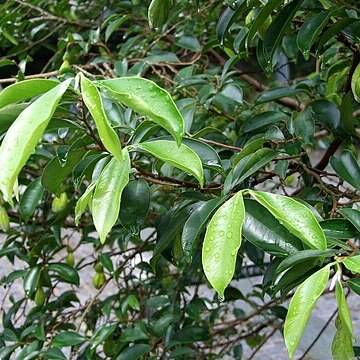Shrubs, treelets or trees. Innovations always pubescent but usually glabrescent. Leaves on the lateral twigs alternate, penninerved; nerves distinct or obscure, simple or sometimes branched, usually slightly curved, ascending towards the margins and joining several intramarginal veins; veins and veinlets numerous, parallel or subparallel; margins wavy, slightly recurved and thickened. Inflorescences axillary or supra-axillary, sometimes on internodes, terminal, or rarely cauliflorous, sessile or short-peduncled, simple or rarely branched, umbelliform or paniculiform, usually without bracts, rarely with a few small ones. Flowers usually 5-merous, pedicelled, articulated at the base of the pedicel. Floral tube cupular to tubular, persistent, in fruit sometimes splitting on one side, outside puberulous or pubescent, inside puberulous with reflexed hairs arranged in lengthwise lines towards the upper part. Calyx lobes (4-)5(-6), reflexed or erect, usually shorter than or rarely as long as the tube. Petaloid appendages twice as many as the lobes, free, or united in a ring (A. cumingiana), inserted at the throat of the tube, lanceolate, ovate, semi-orbicular, or rim-like (A. urdanetensis), each pair opposite the calyx lobe, usually densely pubescent or puberulous. Stamens twice as many as calyx lobes, emerging from the tube at the same level as the appendages, rarely emerging slightly below them, sometimes behind them, sessile or filamentous, equal in length or sepalous ones longer than the others; filaments filiform, sometimes slightly swollen at the upper end; anthers linear-oblong, dorsifixed, free (but in A. cumingiana the lower 1/3-1/2 adnate to the tube); connective broad over the whole length of the anther. Disk none or rarely ringlike. Pistil included. Ovary sessile or stiped, ovoid, oblanceolate or ellipsoid, densely short-puberulous, 2-celled (or incompletely 2-celled in extra-Mal. spp.); style terminal, obscure or distinct, gradually dilated to the ovary, densely puberulous towards the base; stigma distinct, globose, capitate, pyramidal, or oblong, black. Ovule attached near the top of the septum and partly adnate to it. Fruit a loculicidal capsule, globose, obovoid, or oblanceolate, rugose or smooth, sometimes slightly compressed laterally, protruding either from the top or from the split side of the floral tube, distinctly stalked, densely puberulous to glabrous; pericarp coriaceous or woody. Seeds 2, or 1 by abortion, ovoid or ellipsoid; testa crustaceous, sometimes downy, bearing a caruncle-like or tail-shaped appendage at the base; usually the whole seed and sometimes a portion of the appendage is laterally adnate to the septum, with an obscure or a distinct funicle; in the latter case the seeds dangle out of the fruit on the end of the thin funicle in open capsules; albumen none or scant; cotyledons thick, plano-convex.
More
Trees or treelets. Leaves alternate, leaf blade pinnately veined; veins slender, ascending toward margins and joining several intramarginal veins. Inflorescences axillary or terminal, umbelliform or paniculiform, usually without involucre; peduncle short or absent. Flowers bisexual, pedicellate, usually 5-merous. Calyx tube persistent, yellow or yellowish green, campanulate; lobes 5, reflexed or erect. Petaloid appendages twice as many as the lobes, inserted at throat of tube, scalelike, united in a ring at base, usually densely pubescent or puberulous. Stamens twice as many as calyx lobes, alternating with petaloid appendages; filaments short or absent; anthers oblong, dorsifixed, pubescent, connectives broad. Disk absent. Ovary subsessile, pubescent, 2-loculed or incompletely 2-loculed; style very short; stigma capitate. Fruit a 2-valved loculicidal capsule, compressed laterally, obovoid, base enclosed by persistent calyx; pericarp leathery or woody. Seeds 2 or 1 by abortion, ovoid or ellipsoid, on carunclelike strongly tapered funicle; testa crustaceous, endosperm absent; cotyledons thick, plano-convex.

